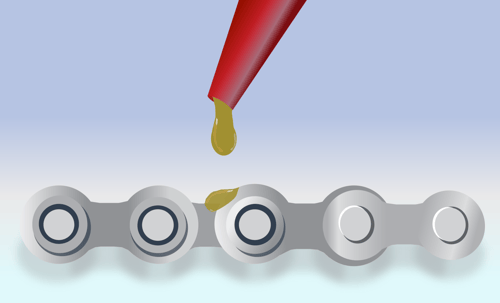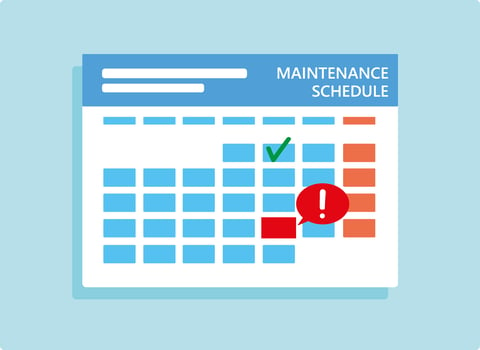Conveyor chain systems have been improving efficiency for production companies for over 100 years. They save manufacturing facilities time and resources and cut labour costs through the automation of manual production operations. While they’re running smoothly, the business prospers and can meet its production schedules and deadlines.
Keeping your conveyor systems running efficiently is the key to maximising your Return on Investment (ROI), which is why maintenance is so essential.
The importance of regular conveyor chain maintenance
When chains are maintained, they provide optimal performance. However, if they are neglected, the daily wear of metal on metal will result in damage such as chain elongation or loss of tensile strength. If not addressed, these issues will eventually bring the conveyor belt, and production, to a halt. Replacing components and making repairs after the machinery has broken down costs you more time, money and resources to fix, than regular maintenance does. It’s also a massive setback to your production schedule.
The best way to avoid these setbacks and optimise your production and chain performance is to conduct maintenance regularly. The most important elements are proper lubrication and the timely replacement of worn parts.
Conveyor chain maintenance tips
Now that you understand the importance of timely maintenance, here are our tips to extend the life of your chains.

1) Lubrication
When metal moves against metal, it creates a lot of friction and wear, drastically reducing the life of your chain and components. Lubricants provide an oily film around the chain and components, lessening the impact of the metal-on-metal contact and slowing the rate of wear.
As well as protecting the metal elements of your conveyor systems, keeping it well-oiled will also reduce the operation noise, and prevent corrosion.
Lubrication is so critical to functionality that manufacturers usually submerge the chains in grease that solidifies in-factory. This grease provides a preliminary protective lubricant before shipping it to buyers.
Lubricants must be applied appropriately to be effective in protecting the chain. You can’t just brush or spray it over the outer surface. Chains consist of a series of joints and bearings, all of which need lubrication to ensure longevity. The lubricant must be applied thoroughly to all areas, including the inner and outer plates, and bearings.
What kind of lubricant should you use?
Environmental factors play a large part in determining the right type of lubricant for your conveyor chain. For example, operation conditions such as temperature, and the amount of dust will require different lubricants for optimum performance.
Some of your options include:
- Low temperature: Water repellent grease
- High Temperature: Wet film lubricant
- Dusty conditions: Dry film lubricant
2) Ensure quality equipment
When it comes to buying the equipment that will become the backbone of your processing, don’t settle for lesser quality for a lower up-front cost. Compromising on quality will only hurt you in the long run when components fail and need replacing.
Only buy from verified drive chain distributors so that you can be assured that you’re getting what you pay for: top quality. As well as quality, you want to make sure that you have the right equipment to suit the application and working environment. For example, if corrosion is a recurring issue for your conveyor system, consider replacing your chains with zinc-plated or stainless-steel ones.

Schedule chain conveyor maintenance
Quality equipment and lubrication are just one aspect of maintaining integrity and extending the life of your chain conveyor system. You should also keep a basic maintenance schedule, along with a logbook, to ensure your operations continue to run smoothly.
Make sure that any staff performing maintenance checks are trained and familiar with their tasks. They’ll also need to record their maintenance and any necessary data appropriately in the logbook.
These are the basic maintenance requirements for a chain conveyor system. We recommend that you check the manual for any specific or additional requirements for your equipment:
Daily maintenance:
- Inspect the conveyor chains daily for signs of wear and elongation.
- Remove any debris that may have accumulated in the chain.
- Check the drivetrain tensioners and lubricate drive sprockets as required.
Weekly maintenance:
- All chains, sprockets, and components need to be inspected and lubricated as required.
- Check that the drivetrain tensioners are within the acceptable range.
Monthly maintenance:
- Remove any covers such as side guards and clean them and the areas they protect, clearing out any debris.
- Clean all cooling components and inspect them for proper performance.
Quarterly maintenance:
- Thoroughly check sprockets for wear and replace any as necessary: warped sprockets can cause elongation of the chain.
- Thoroughly check the chain for wear and elongation.
- Check the sprocket and shaft alignments.
- Check for any unusual wear, identify the cause, and then correct it.
- If you have an automated lubrication system set up for your chain, remember to clean the sump and change the oil filter.
It may not be quarterly, but at regular points throughout the year, look at your maintenance logs and inspect the conveyor chain and track. If there are any significant issues, or concerning trends, (such as incomplete or missing logbook entries) address the matter with your maintenance staff, as it could indicate that regular maintenance has been neglected.

3) Read the manual
Conveyor chain manufacturers know exactly what’s required to get the most from your chains. The manuals they provide with their products will tell you what maintenance is needed, and how often it should be performed to extend the life of the chain. Reading the manual may seem like a time-consuming task; however, having your maintenance staff and facilities managers become familiar with the equipment they’re using is crucial to proper maintenance.
There you have it!
At SLS Bearings, we partner with conveyor chain manufacturers and brand principals to ensure that we provide you with not just quality brands, but also quality service. Our experienced technical professionals are certified and officially trained by our brand principals. The next time you want to schedule installation and maintenance services or would like to know more about conveyor chains, please get in touch with us below:
*The feature image was derived from Tsubaki







